|
|
Hanns Eisler (Composer) |
|
Born: July 6, 1898 - Leipzig, Germany
Died: September 6, 1962 - East Berlin, Germany |
|
The German-born Austrian composer, was born in Leipzig where his Jewish father, Rudolf Eisler, was a professor of philosophy. In 1901 the family moved to Vienna. His sister was Ruth Fischer (Elfriede Eisler), a leader of the German Communist Party (KPD) during the 1920’s, author of several books, and from 2010, confirmed to have been a CIA spy. His brother was the journalist and Communist Gerhart Eisler, who was believed to be a major Comintern agent operating under the cover name of Hans Berger. Louis Budenz, a former managing editor of the Daily Worker, called him in a speech in the fall of 1946 "the Number One Communist in the U.S.". Time Magazine wrote of him, "He turned up in China, charged with purging the party of spies and dissidents, sent so many men to their deaths that he was known as 'The Executioner'".
During World War I Hanns Eisler served as a front-line soldier in the Austro-Hungarian army and was wounded several times in combat. Returning to Vienna after Austria's defeat, he studied from 1919 to 1923 under Arnold Schoenberg. Eisler was the first of A. Schoenberg's disciples to compose in the twelve-tone or serial technique. He married Charlotte Demant in 1920; they separated in 1934.
In 1925 Hanns Eisler moved to Berlin - then a hothouse of experimentation in music, theater, film, art and politics. There he became a member of the Communist Party of Germany and became involved with the November Group. In 1928, he taught at the Marxist Worker's School in Berlin and his son Georg Eisler, who would grow up to become an important painter, was born.
His music became increasingly oriented towards political themes and, to A. Schoenberg's dismay, more "popular" in style with influences drawn from jazz and cabaret. At the same time, he drew close to Bertolt Brecht, whose own turn towards Marxism happened at about the same time. The collaboration between the two artists lasted for the rest of Brecht's life.
In 1929, Hanns Eisler composed the song cycle Zeitungsausschnitte, Op. 11. The piece is dedicated to Margot Hinnenberg-Lefebre. Though not written in the twelve-tone technique, the piece was perhaps the forerunner of a musical art style later known as "News Items" - musical compositions that parodied a newspaper's content and style, or that included lyrics lifted directly from newspapers, leaflets, magazines, and other written media of the day. Eisler's piece parodies a newspaper's layout and content, with songs in the cycle given titles similar to headlines. The piece offers evidence of Eisler's socialist leanings, as its lyrics indicate the struggles of ordinary Germans who, after World War I, encountered hardship.
Hanns Eisler also wrote music for several Brecht plays, including The Decision (1930), The Mother (1932) and Schweik in the Second World War (1957). They also collaborated on protest songs that intervened in the political turmoil of Weimar Germany in the early 1930’s. Their Solidarity Song became a popular militant anthem sung in street protests and public meetings throughout Europe, and their Ballad of Paragraph 218 was the world's first song protesting laws against abortion. Brecht-Eisler songs of this period tended to look at life from "below" - from the perspective of prostitutes, hustlers, the unemployed and the working poor. He worked with Brecht and the director Slatan Dudow on the film Kuhle Wampe which was banned by the Nazis in 1933.
After 1933, Hanns Eisler's music and Brecht's poetry were banned by the Nazi Party. Both artists fled, first to Moscow, where The Decision was produced and staged. Eventually, Eisler and Brecht sought refuge in the USA, along with other exiles fleeing Nazi Germany.
In New York City, Hanns Eisler taught composition at the New School and wrote experimental chamber and documentary music. Moving shortly before World War II to Los Angeles, he composed several Hollywood film scores, two of which - Hangmen Also Die! and None but the Lonely Heart - were nominated for Oscars. Also working on Hangmen Also Die! was Bertolt Brecht, who wrote the story along with director Fritz Lang. In 1947, he wrote the book Composing for the Films with Theodor W. Adorno. In several chamber and choral compositions of this period, Eisler returned to the twelve-tone method he had abandoned in Berlin. His Fourteen Ways of Describing the Rain - composed for Arnold Schoenberg's 70th birthday celebration - is considered a masterpiece of the genre.
Hanns Eisler's two most notable works of the 1930’s and 1940’s were the monumental Deutsche Sinfonie (1935-1957) - a choral symphony in eleven movements based on poems by Brecht and Ignazio Silone - and a cycle of art songs published as the Hollywood Songbook (1938-1943). With lyrics by Brecht, Eduard Mörike, Friedrich Hölderlin and Goethe, it established Eisler's reputation as one of the 20th century's great composers of German lieder.
Hanns Eisler's promising career in the U.S. was interrupted by the Cold War. He was one of the first artists placed on the Hollywood blacklist by the movie studio bosses. In two interrogations by the House Committee on Un-American Activities, the composer was accused of being "the Karl Marx of music" and the chief Soviet agent in Hollywood. Among his accusers was his sister Ruth Fischer, who also testified before the House Committee that her other brother, Gerhart, was a major Communist agent. The Communist press denounced her as a "German Trotskyite." Among the works that Eisler composed for the Communist Party was the "Comintern March", "The Comintern calls you / Raise high Soviet banner / In steeled ranks to battle / Raise sickle and hammer." Eisler's supporters - including his friend Charlie Chaplin and the composers Igor Stravinsky, Aaron Copland and Leonard Bernstein - organized benefit concerts to raise money for his defense fund, but he was deported early in 1948.
Hanns Eisler returned to Germany and settled in East Berlin. Back in East Germany, he composed the national anthem of the German Democratic Republic, a cycle of cabaret-style songs to satirical poems by Kurt Tucholsky, and incidental music for theater, films and television. His most ambitious project of the period was a modern opera on the Faust theme. The libretto, which he published in 1952, portrayed Faust as an indecisive person who betrayed the cause of the working class by not joining the German Peasants' War. This interpretation was attacked by the official GDR press and even by Walter Ulbricht and was refused authorization by a cultural commission summoned specially for the case by the Berlin Academy of Arts. All of these disapproved of the negative depiction of Faust as a renegade and accused the work of being "a slap in the face of German national feeling" (Neues Deutschland) and of having "formalistically deformed one of the greatest works of our German poet Goethe" (Ulbricht). Disheartened, Eisler stopped work on the music for the opera and it was never completed. Ironically, less than five years after his deportation from the USA, Eisler was again forced to testify in hearings where his political loyalty was questioned. lthough he continued to work as a composer and to teach at the East Berlin conservatory, the gap between Eisler and the cultural functionaries of East Germany grew wider in the last decade of his life. During this period, he befriended musician Wolf Biermann, whose critical attitude towards the GDR government later led to exile in West Germany.
Hanns Eisler collaborated with Brecht until the latter's death in 1. He never recovered completely from his friend's demise and his remaining years were marred by depression and declining health. He died of a heart attack (his second) in East Berlin and is buried near Brecht in the Dorotheenstadt cemetery. |
|
Compositions |
|
1918: Gesang des Abgeschiedenen (Die Mausefalle (after Christian Morgenstern); Wenn es nur einmal so ganz still wäre (after Rainer Maria Rilke)
1919: Drei Lieder (Li-Tai-Po, Klabund); Sehr leises Gehn im lauen Wind; Spartakus
1922: Allegro moderato and Waltzes; Allegretto and Andante for Piano
Divertimento; Four Piano Pieces
1925: Eight Piano Pieces
1926: Tagebuch des Hanns Eisler (Diary of Hanns Eisler); 11 Zeitungsausschnitte; Ten Lieder; Three Songs for Men's Chorus (after Heinrich Heine) (1926)
1928: Drum sag der SPD ade; Lied der roten Matrosen ("Song of the Red Sailors", with Erich Weinert); Pantomime (with Béla Balázs); Kumpellied; Red Sailors' Song; Couplet vom Zeitfreiwilligen; Newspaper's Son; Auch ein Schumacher (verschiedene Dichter); Was möchst du nicht (from Des Knaben Wunderhorn); Wir sind das rote Sprachrohr
1929: Tempo der Zeit (Tempo of Time) for chorus and small orchestra, op. 16; Six Lieder (after Weinert, Weber, Jahnke and Vallentin); Lied der Werktätigen ("Song of the Working People"; with Stephan Hermlin)
1930: Die Maßnahme ("The Measure", Lehrstück, text of Bertolt Brecht), Op. 20; Six Ballads (after Weber, Brecht, and Walter Mehring); Four Ballads (after B. Traven, Kurt Tucholsky, Wiesner-Gmeyner, and Arendt); Suite No. 1, Op. 23
1931: Lied der roten Flieger (after Kirsanow); Four Songs (after Frank, Weinert) from the film Niemandsland'; Three Songs from the film Kuhle Wampe (texts of Brecht); Ballad of the Pirates, Song of Mariken, Four Ballads (with Bertolt Brecht); Suite No. 2, Op. 24 (Niemandsland); Three Songs after Erich Weinert; Das Lied vom vierten Mann ("The Song of the Fourth Man"); Streiklied ("Strike Song"); Suite No. 3, Op. 26 (Kuhle Wampe)
1932: Ballad of the Women and the Soldiers (with Brecht); Song from the Urals (after Tretyakov); Seven Piano Pieces; Kleine Sinfonie (Little Symphony); Suite No. 4, Op. 30 (Die Jugend hat das Wort)
1934: Einheitsfrontlied ("United Front Song"); Saarlied ("Saar Song"), Lied gegen den Krieg ("Song Against War"), Ballade von der Judenhure Marie Sanders ("Ballad of the Jews' Whore Marie Sanders"), Songs from Die Rundköpfe und die Spitzköpfe; Sklave, wer wird dich befreien ("Slave, who will liberate you"; with Brecht); "California Ballad"; Six Pieces; Prelude and Fugue on B–A–C–H (string trio)
1935: Die Mutter ("The Mothers", with Brecht; cantata)
1935: Lenin Requiem for solo voices, chorus & orchestra
1937: Friedenssong ("Peace Song", after Petere); Kammerkantaten ("Chamber Cantatas"); Ulm 1592; Bettellied ("Begging Song", with Brecht); Lenin Requiem (with Brecht)
1938: Cantata on Herr Meyers' First Birthday; String Quartet; Theme and Variations Der lange Marsch
1939: Nonet No. 1
1940: Chamber Symphony; Suite for Septet No. 1
1940-1941: Film Music to The Forgotten Village
1940-1941: Nonet No. 2
1941: Woodburry-Liederbüchlein (Woodbury Songbook, 20 Songs); 14 Arten (for the 70th birthday of Arnold Schoenberg)
1942: Hollywood-Elegien ("Hollywood Elegies"; with Brecht) in the Hollywooder Liederbuch (Hollywood Songbook)
1943: Film music for Hangmen Also Die!; Piano Sonata No. 3
1943: Songs to Schweik in the Second World War; Deutsche Misere (with Brecht)
1946: Glückliche Fahrt ("Prosperous Voyage", after Goethe); Incidental music to The Life of Galileo
1946: Film score for A Scandal in Paris
1947: Septet No. 2
1947: music for The Woman on the Beach, film directed by Jean Renoir
1948: Lied über die Gerechtigkeit ("Song of Justice", after W. Fischer)
1949: Rhapsody; Lied über den Frieden ("Song about Peace"); National Anthem of the DDR (text by Becher); Treffass
1950: Mitte des Jahrhunderts (after Becher); Four Lieder on Die Tage der Commune; Children's Songs (with Brecht)
1952: Das Lied vom Glück ("The Song of Happiness"; after Brecht); Das Vorbild (after Goethe)
1955: Night and Fog (film), Songs for the film Herr Puntila und sein Knecht Matti; Im Blumengarten ("In the flower garden"); Die haltbare Graugans; Three Lieder after Brecht; Bel Ami
1956: Vier Szenen auf dem Lande ("Four Scenes from the Country", after Erwin Strittmatter); Children's Songs (after Brecht); Fidelio (after L.v. Beethoven)
1957: Deutsche Sinfonie (after texts of Bertolt Brecht and Ignazio Silone); Bilder aus der Kriegsfibel; Die Teppichweber von Kujan-Bulak ("The Carpetweavers of Kujan-Bulak", with Brecht); Lied der Tankisten (text by Weinert); Regimenter gehn; Marsch der Zeit ("March of Time", after Mayakovsky); Three Lieder (after Mayakovsky and Peter Hacks); Sputnik-Lied ("Sputnik Song", text of Kuba)
1958: Am 1. Mai ("To May Day", with Brecht)
1962: Ernste Gesänge ("Serious Songs"), seven Lieder after Friedrich Hölderlin, Viertel, Giacomo Leopardi, Richter, and Stephan Hermlin |
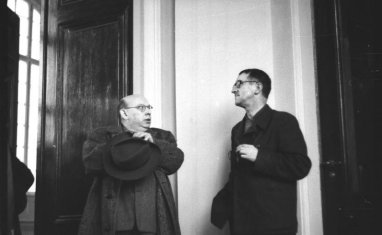 |
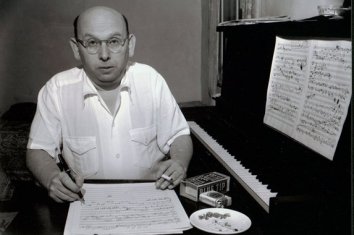
|
|
Hanns Eisler (left) and Bertolt Brecht, his close friend and collaborator, 1950 [01] |
1942
[05] |
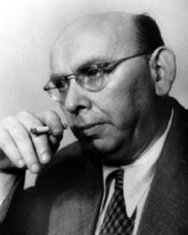
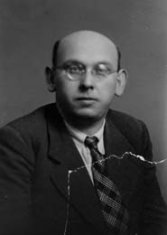
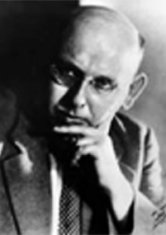
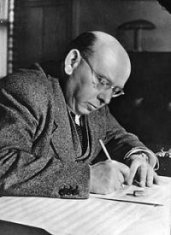
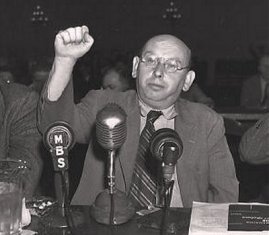
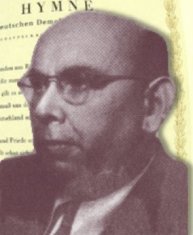
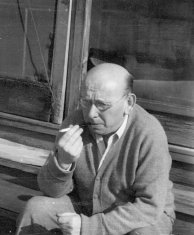
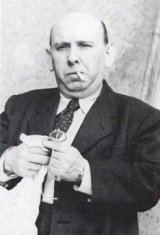
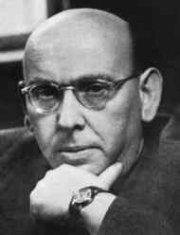
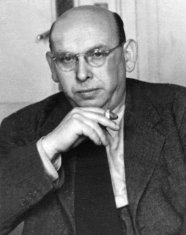 |
|
Source: Wikipedia Website (November 2011)
Contributed by Aryeh Oron (November 2011) |
|
Hanns Eisler : Short Biography | Arrangements/Transcriptions: Works | Recordings |
|
Links to other Sites |
|
International Hanns Eisler Society
Eisler Music
Hanns Eisler Project |
Hanns Eisler (Wikipedia)
Hans Eisler - Biography (IMDB) |
|
Bibliography |
| |
|
|